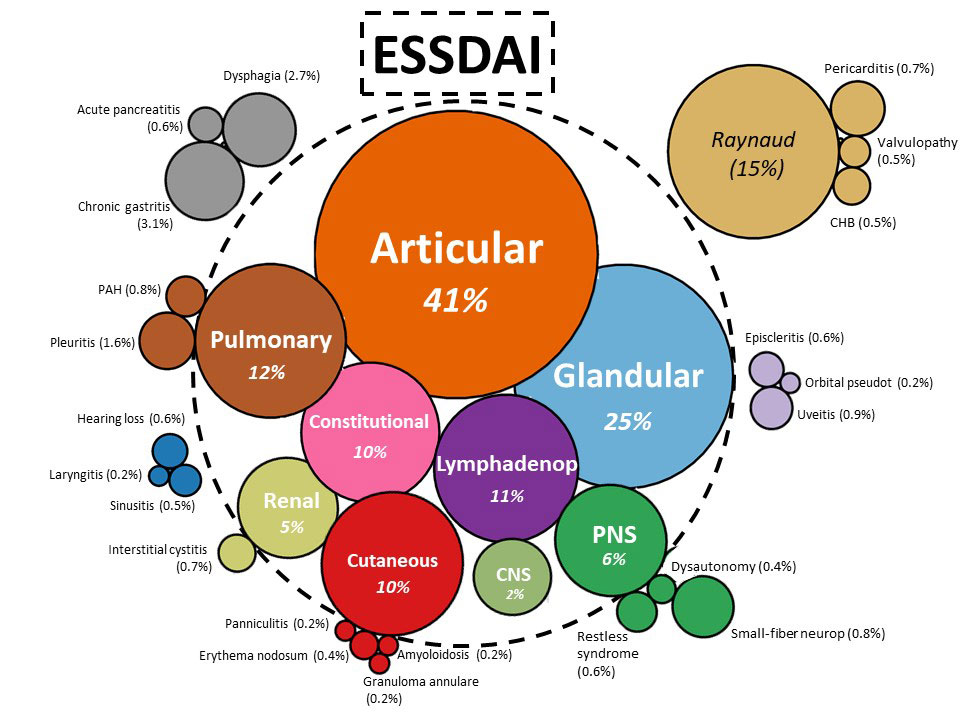Session Information
Session Type: Poster Session (Monday)
Session Time: 9:00AM-11:00AM
Background/Purpose: To analyse the frequency and characterize the systemic presentation of primary Sjögren syndrome (SjS) out of the ESSDAI classification in a large international, multi-ethnic cohort of patients.
Methods: The Big Data Sjögren Project Consortium is an international, multicentre registry based on worldwide data-sharing and cooperative merging of pre-existing clinical SjS databases from leading centres in clinical research in SjS from the five continents. A list of 26 organ-by-organ systemic features not currently included in the ESSDAI classification was defined according to previous studies; these features were retrospectively recorded.
Results: Information about non-ESSDAI features was available in 6331 patients (5,917 female, mean age at diagnosis 52 years, mainly White (86.3%). A total of 1641 (26%) of 6331 patients presented at least one of the out of ESSDAI systemic features listed in Annex 1; among them, there were 359 (22%) patients who presented two or more of these features. The most frequent organs involved included cardiovascular in 1079 (17%) patients, digestive in 390 (6.2%), pulmonary in 145 (2.3%), neurological in 110 (1.7%), ocular in 97 (1.5%), ENT in 80 (1.3%), cutaneous in 55 (0.9%) and urological features in 43 (0.7%) patients (Figure). Cardiovascular manifestations were the most frequent organ-specific group of non-ESSDAI features reported in our patients (17% of the total cohort), with Raynaud phenomenon being reported in 15%. Patients with systemic disease due to non-ESSDAI features had a lower frequency of dry mouth (90.7% vs 94.1%, p< 0.001) and positive minor salivary gland biopsy (86.7% vs 89%, p=0.033), a higher frequency of anti-Ro/SSA (74.7% vs 68.7%, p< 0.001), anti-La/SSB antibodies (44.5% vs 40.4%, p=0.004), ANA (82.7% vs 79.5%, p=0.006), low C3 levels (17.4% vs 9.7%, p< 0.001), low C4 levels (14.4% vs 9.6%, p< 0.001), and positive serum cryoglobulins (8.6% vs 5.5%, p=0.001). Systemic activity measured by the ESSDAI, clinESSDAI and DAS was higher in patients with systemic disease out of the ESSDAI in comparison with those without these features (p< 0.001 for all comparisons).
Conclusion: More than a quarter of patients with primary SjS may have systemic manifestations not currently included in the ESSDAI classification, with a wide variety of cardiovascular, digestive, pulmonary, neurological, ocular, ENT, cutaneous and urological features that increase the scope of the systemic phenotype of the disease. However, the individual frequency of each of these non-ESSDAI features was very low, except for Raynaud phenomenon. The results of this study, together with the already-published evidence supporting a pivotal role of systemic disease in primary SjS, are pointing out the need of a future re-evaluation about how we are defining, classifying and diagnosing primary SjS.
To cite this abstract in AMA style:
Retamozo S, Acar-Denizli N, Rasmussen A, Horváth I, Baldini C, Priori R, Sandhya P, Hernandez-Molina G, Armagan B, PRAPROTNIK S, Kvarnstrom M, Gerli R, Sebastian A, Solans-Laqué R, Rischmueller M, Pasoto S, Valim V, Nordmark G, Kruize A, Nakamura T, Hofauer B, Giacomelli R, Fernandes Moça Trevisani V, Devauchelle Pensec V, Atzeni F, Gheita T, Consani-Fernández S, Szántó A, Sivils K, Gattamelata A, Danda D, Kilic L, Bartoloni E, Bombardieri S, Sánchez-Guerrero J, Wahren-Herlenius M, Mariette X, Ramos-Casals M, Brito-Zerón P. Systemic Manifestations of Primary Sjögren Syndrome out of the ESSDAI Classification: Prevalence and Clinical Relevance in a Large International, Multi-ethnic Cohort of Patients [abstract]. Arthritis Rheumatol. 2019; 71 (suppl 10). https://acrabstracts.org/abstract/systemic-manifestations-of-primary-sjogren-syndrome-out-of-the-essdai-classification-prevalence-and-clinical-relevance-in-a-large-international-multi-ethnic-cohort-of-patients/. Accessed .« Back to 2019 ACR/ARP Annual Meeting
ACR Meeting Abstracts - https://acrabstracts.org/abstract/systemic-manifestations-of-primary-sjogren-syndrome-out-of-the-essdai-classification-prevalence-and-clinical-relevance-in-a-large-international-multi-ethnic-cohort-of-patients/

